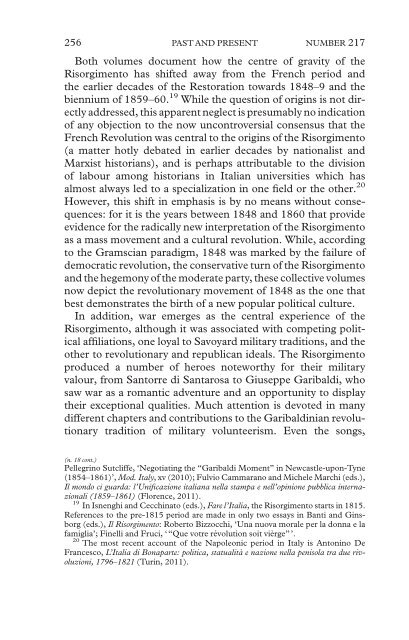Here - Dominique Kirchner Reill
Here - Dominique Kirchner Reill
Here - Dominique Kirchner Reill
Create successful ePaper yourself
Turn your PDF publications into a flip-book with our unique Google optimized e-Paper software.
256 PAST AND PRESENT NUMBER 217<br />
Both volumes document how the centre of gravity of the<br />
Risorgimento has shifted away from the French period and<br />
the earlier decades of the Restoration towards 1848–9 and the<br />
biennium of 1859–60. 19 While the question of origins is not directly<br />
addressed, this apparent neglect is presumably no indication<br />
of any objection to the now uncontroversial consensus that the<br />
French Revolution was central to the origins of the Risorgimento<br />
(a matter hotly debated in earlier decades by nationalist and<br />
Marxist historians), and is perhaps attributable to the division<br />
of labour among historians in Italian universities which has<br />
almost always led to a specialization in one field or the other. 20<br />
However, this shift in emphasis is by no means without consequences:<br />
for it is the years between 1848 and 1860 that provide<br />
evidence for the radically new interpretation of the Risorgimento<br />
as a mass movement and a cultural revolution. While, according<br />
to the Gramscian paradigm, 1848 was marked by the failure of<br />
democratic revolution, the conservative turn of the Risorgimento<br />
and the hegemony of the moderate party, these collective volumes<br />
now depict the revolutionary movement of 1848 as the one that<br />
best demonstrates the birth of a new popular political culture.<br />
In addition, war emerges as the central experience of the<br />
Risorgimento, although it was associated with competing political<br />
affiliations, one loyal to Savoyard military traditions, and the<br />
other to revolutionary and republican ideals. The Risorgimento<br />
produced a number of heroes noteworthy for their military<br />
valour, from Santorre di Santarosa to Giuseppe Garibaldi, who<br />
saw war as a romantic adventure and an opportunity to display<br />
their exceptional qualities. Much attention is devoted in many<br />
different chapters and contributions to the Garibaldinian revolutionary<br />
tradition of military volunteerism. Even the songs,<br />
(n. 18 cont.)<br />
Pellegrino Sutcliffe, ‘Negotiating the ‘‘Garibaldi Moment’’ in Newcastle-upon-Tyne<br />
(1854–1861)’, Mod. Italy, xv (2010); Fulvio Cammarano and Michele Marchi (eds.),<br />
Il mondo ci guarda: l’Unificazione italiana nella stampa e nell’opinione pubblica internazionali<br />
(1859–1861) (Florence, 2011).<br />
19 In Isnenghi and Cecchinato (eds.), Fare l’Italia, the Risorgimento starts in 1815.<br />
References to the pre-1815 period are made in only two essays in Banti and Ginsborg<br />
(eds.), Il Risorgimento: Roberto Bizzocchi, ‘Una nuova morale per la donna e la<br />
famiglia’; Finelli and Fruci, ‘‘‘Que votre révolution soit vièrge’’’.<br />
20 The most recent account of the Napoleonic period in Italy is Antonino De<br />
Francesco, L’Italia di Bonaparte: politica, statualità e nazione nella penisola tra due rivoluzioni,<br />
1796–1821 (Turin, 2011).


